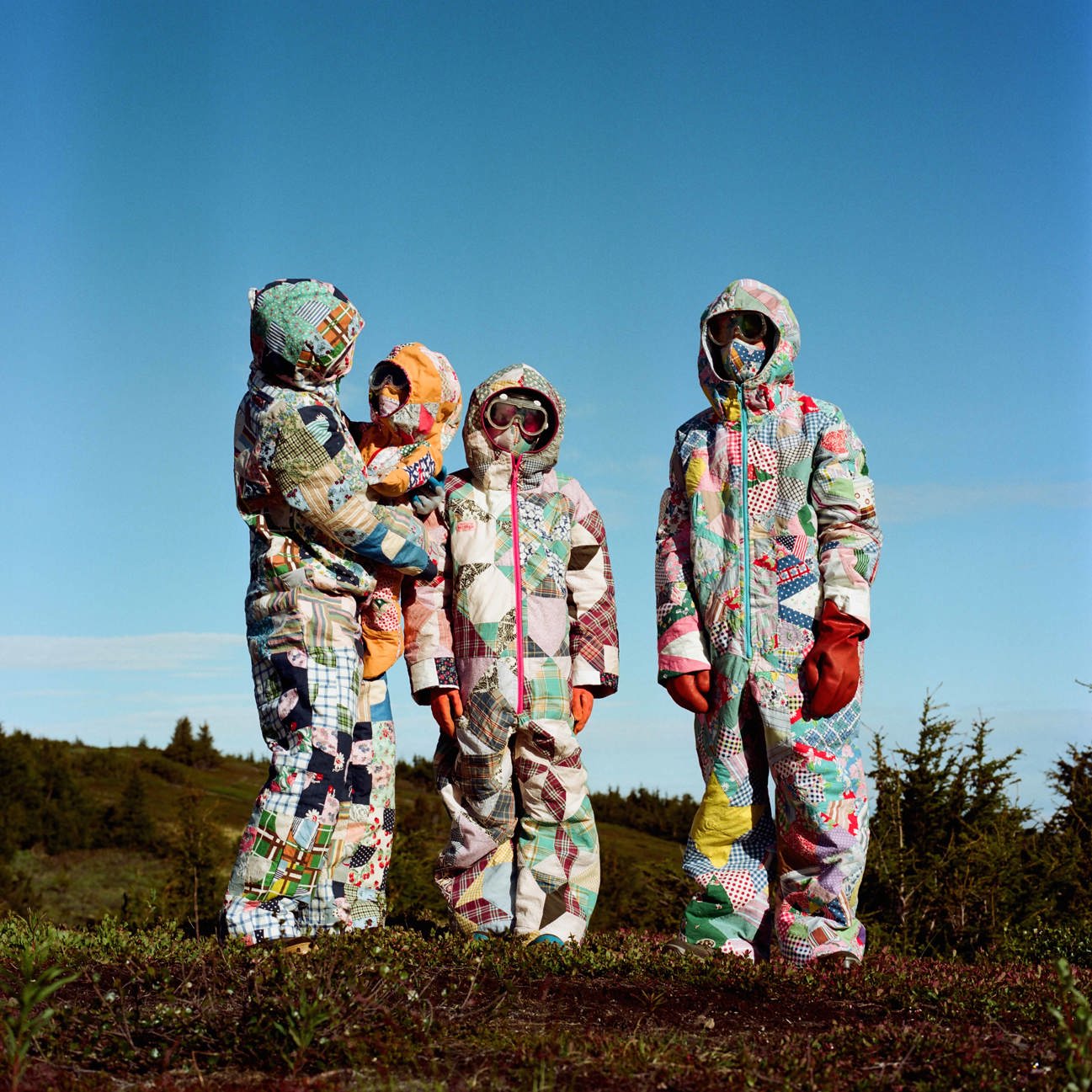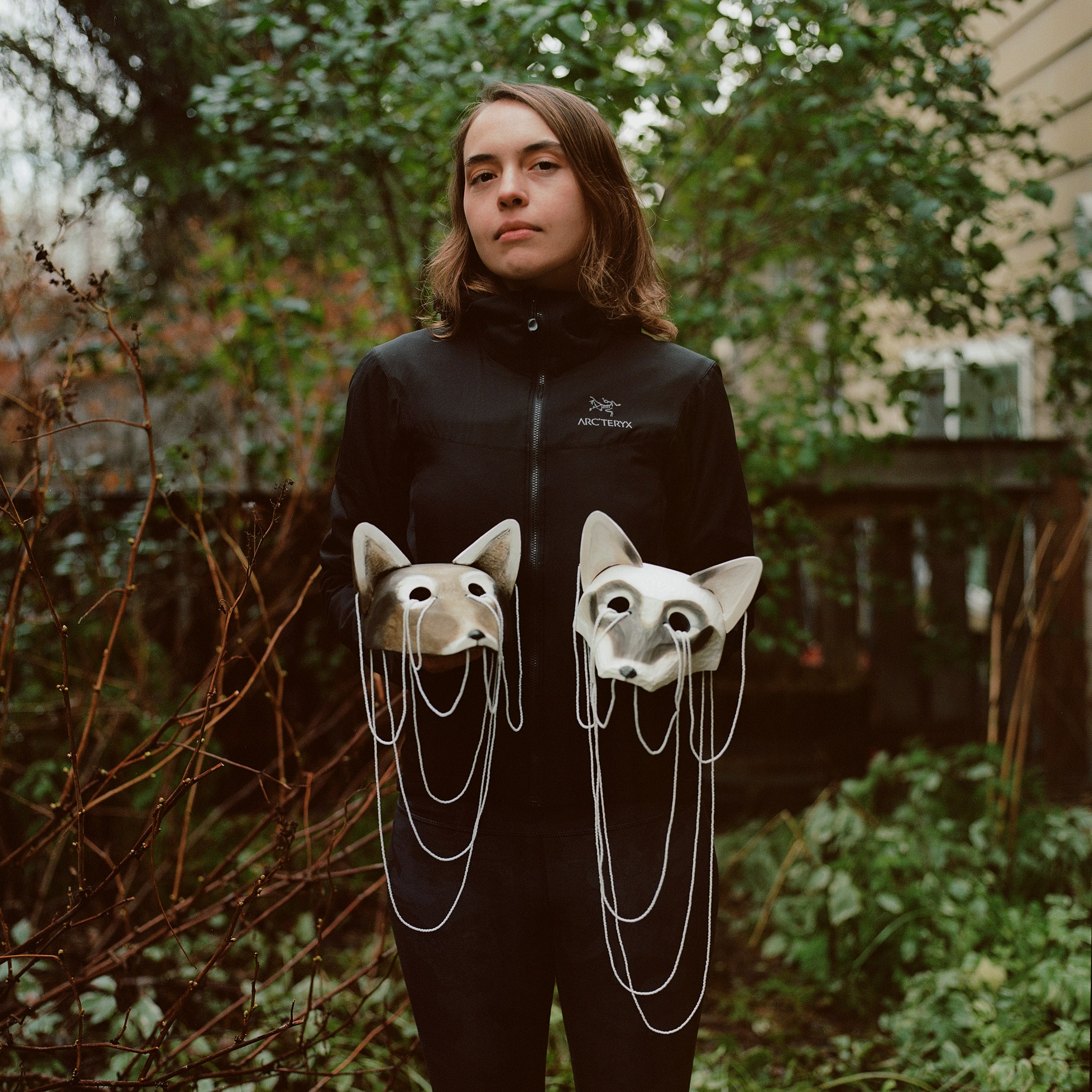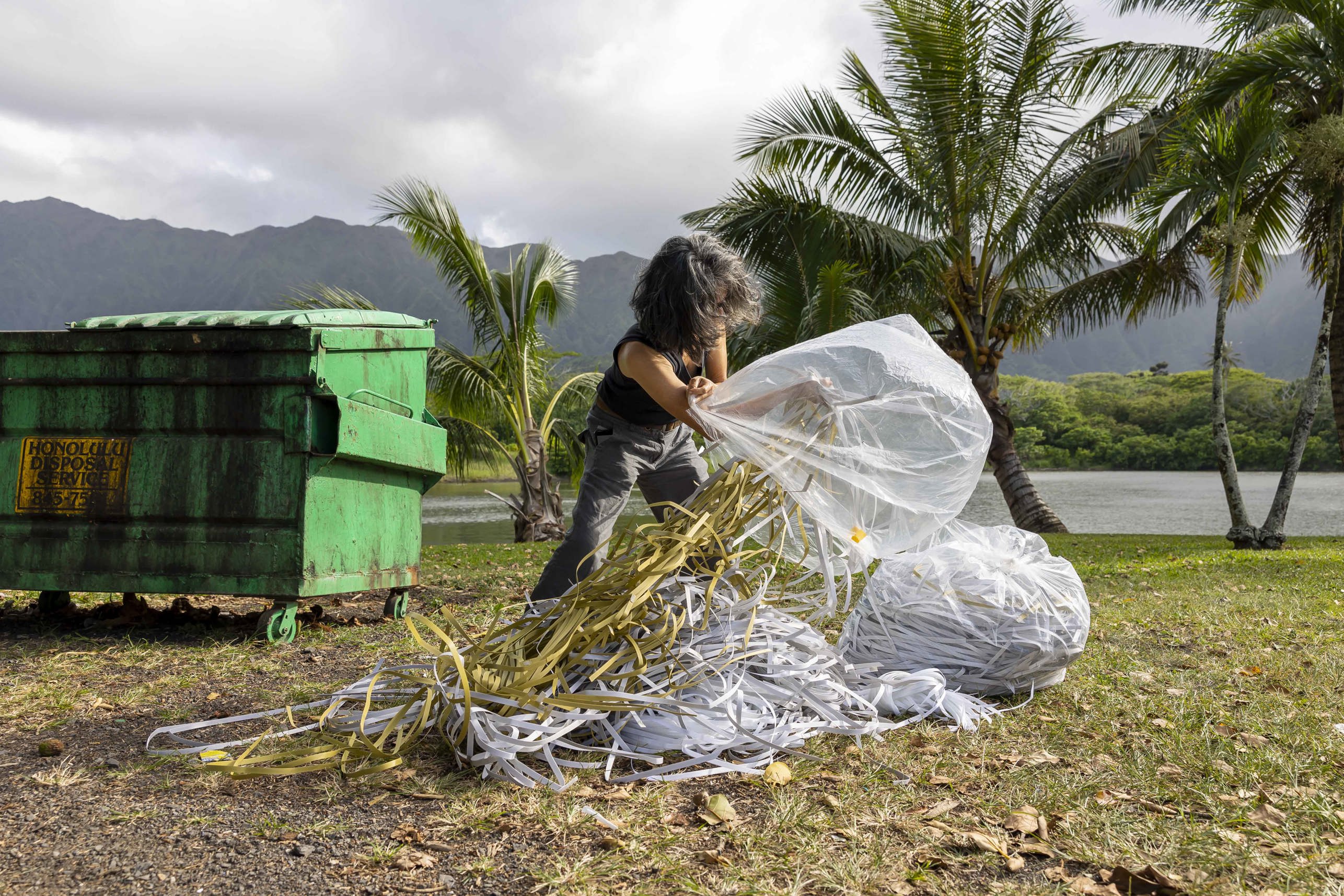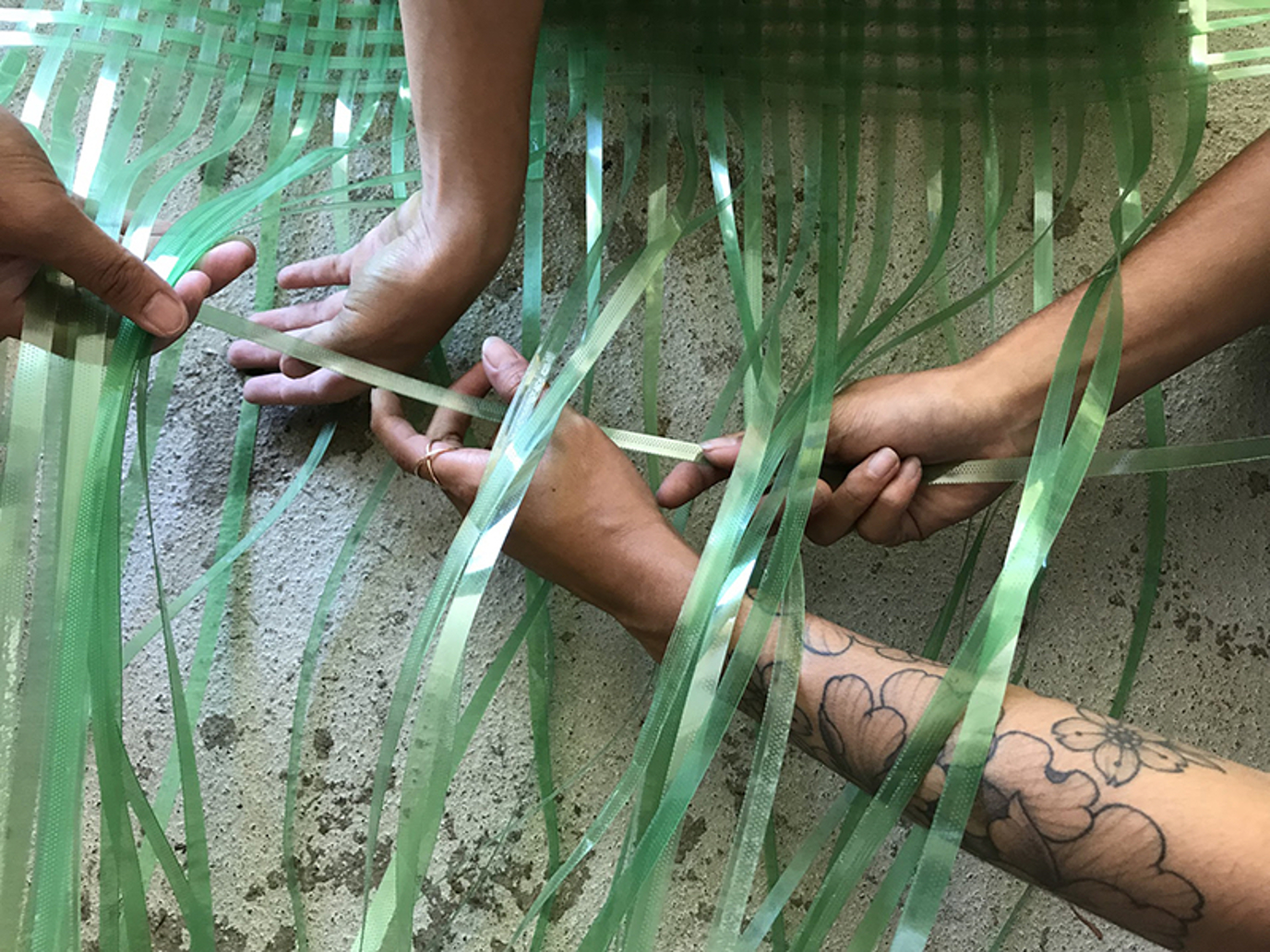
How to Survive: Three Artists on Climate, Care, and the Future
October 01, 2023
By Francesca Dubrock, Chief Curator
Chinese-American activist and philosopher Grace Lee Boggs once said “The only way to survive is by taking care of one another.” Opening this fall at the Anchorage Museum, How to Survive is an exhibition that examines how ethics of care can help us face interlocking crises stemming from climate change. Here, curator Francesca Du Brock catches up with three participating artists.
Gaye Chan is a conceptual artist who works between solo and collaborative activities that take place on the web, on public streets, and in galleries as well as through publications. She was born in Hong Kong and is based in Kāneoh'e, Hawai'i.
Erin Ggaadimits Ivalu Gingrich is an artist of Koyukon Athabascan, Inupiaq, and settler heritage. Her carved, beaded, and painted work honors ancestral practices of gathering and harvesting, paying tribute to the wild beings that sustain Indigenous lifeways.
Amy Meissner is an Alaska-based artist of Swedish descent who combines traditional handwork, found objects, and abandoned textiles to reference the literal, physical, and emotional work of women. She also teaches classes on garment and textile repair.

Amy Meissner, “Mother Thought of Everything,” 2020. Pandemic suits made from used Tyvek, abandoned quilts, and used household protective equipment. Collection of the Anchorage Museum. Photo by Brian Adams.
You each work with natural, scavenged, and upcycled materials. Could you comment on your relationship to material and how that informs the conceptual underpinnings of your work?
AM: I work with abandoned, unwanted, or unfinished domestic textiles made primarily by women for the home. These inherited textiles are burdensome for people in contemporary society to store, move, maintain, care for… so offloading them generally brings about a sense of relief or release. In 2018, I completed The Inheritance Project whereby I became the final inheritor of this kind of women's handwork people didn’t want to keep anymore. I’ve continued working exclusively with these materials, in part, because this is what I grew up with. My mother was raised by her grandmother in Sweden, and this is what the women in her family did every night after the farm work was done. They sat around the kitchen table and either repaired garments and textiles, or made new textiles for the home, primarily through embroidery or crochet. So that is how I was raised. There is a physical and emotional labor expressed in these textiles, and this forms the conceptual basis of my work.
GC: In a sense, I think of everything as a found object because nothing is new. We go to the art store or wherever to buy supplies, thinking as if these things are new. And I have come to realize that nothing is new, and everything comes into being because of so many forces: technology, capitalism, nationalism, colonialism, labor, exploitation. I like thinking: How do I come into being? How did I even end up being here? How do these jobs end up being where they are? How do we come to have these ideas about what is trash and what is worth lots of money? The work that I do is about pausing and looking at a material, thinking about it, interacting with it in this way.
Also, my work for the last ten years at least, if not longer, has really had to do with strangers or who we come to define as strangers. I think about this in different ways. One is like the horrible trash that we find—let's contrast, say, this ceramic cup that my grandfather made himself, or that terrible Styrofoam cup that someone tossed in my driveway. But that cup is made by somebody's grandfather, too. I'm very interested in that Styrofoam cup and why that person's labor, his knowledge and skill, is less valued—or even hated, you know? And this brings me to question how we categorize skilled or unskilled labor. And I really think this has everything to do with capitalism; many of us had to be deskilled so that we become reliant on the labor of others. And this is how we justify exploitation of people—by not caring about their labor. And then conversely, we value certain kinds of craftspeople or artists. Because of this, I’m moving away from what is typically called “studio practice” and trying to dematerialize my work to the point where I disappear.
EG: The materials I represent in my carved and beaded works are based on notions of harvest and the subsistence practices that I'm very fortunate to get to cultivate and continue. I try to go home to Nome at least once a year to pick berries with my elders. They feed me and feed my work, and I create representations of what I'm eating and what makes me, and what has made me. Because I am made up of things that were harvested years ago, that my mother harvested, that my grandmother harvested. These materials make me and in turn make up my work through the transfer of substance and nutrition. These living beings, non-human beings, that I get to consume become a part of me and then become a part of my work.
Your practices are part of a nexus of other activities, including wild harvest, skill sharing, and activism. How do you see the creative process as part of a larger lifecycle of learning, sharing, and consciousness-raising?
GC: I often work with found objects as part of an expanded social practice that I've been involved in since 2003. It’s sort of an anarchist system where we set up different platforms for exchange outside of the market and state control, like free stores, guerilla gardens, and free meals. I started making baskets about ten years ago when I found a bunch of plastic baling straps outside a distributor. Since there are very few recycling opportunities for that kind of material, I learned how to weave baskets with the straps. I have been teaching others, doing demonstrations and online tutorials, and training other teachers. I've probably made over 1,000 baskets, and I’m finally getting better at it! I think I'm coming at this material not only to get it out of the waste stream, but to ask why we end up with all this crap in the first place. And it's because of globalism. It’s because of this dysfunctional system of moving goods around and the residue that gets left in the wake of commerce. I use this material in a very tangible way, but it’s not just about the straps, it’s about broader systems of violence and exploitation.
AM: My work doesn’t exist without the labor of other women, the majority of whom I’ve never met or who are gone and can’t tell me why they made these textiles or what their hopes were while they made them. But I find them incredibly hopeful objects. Otherwise, why would you infuse something with thousands of hours of attention, if there wasn't hope for the future potentiality of that object? That last piece is what propels my social practice: I choose to teach the craft of repair and instill that sense of prolonging and hopefulness. We have our things for the short span of our lifetime, but that isn’t a reason to not care for them or for people we’ll never meet who will acquire these things later.
EG: My practice is rooted in honoring gifts that are gathered from the land, the subsistence resources that have fed me and my family and my elders and my culture for generations and generations. I represent the things that have kept me here and kept my family here and kept my ancestors here, in particular. I am made of moose that were harvested and hunted generations ago. I'm made of berries that were harvested and picked in the '60s. I’m made of salmon that were caught last year. What I do is just a part of a discourse that has been ongoing in my culture for generations and millennia—being a part of a tradition of representing things that make us and take care of us, these gifts we gather from the land. The fish that I carve have been getting better and better and better the more I go out and spend time with them, the more I continue this relationship that we’re very fortunate to have.
Can art help us face the challenges of climate collapse, and what abilities do we need to nurture as we contemplate uncertain futures?
AM: We need to make things for next generations and infuse those things with the kind of care that allows them to last for the next receiver, the next owner or the next encounterer. This needs to extend to everything we make or generate—however temporary—and this includes our ideas, too. We need to infuse all those things with an ethic of care for those complete strangers. They might be our family. I have future grandchildren I’ve not met but hope are coming. So how can I receive them through objects that show how much I care? This means making things, perhaps, from materials or with materials that aren't just sustainable but also regenerative. I think a lot about how my art practice can be regenerative, and I think that's where teaching comes in. I think that's a regenerative component of practice that does address climate collapse. Information must be shared freely and generously.
 Amy Meissner teaching the “Craft of Repair” at the Anchorage Museum’s Seed Lab. Image courtesy of Anchorage Museum.
Amy Meissner teaching the “Craft of Repair” at the Anchorage Museum’s Seed Lab. Image courtesy of Anchorage Museum.
EG: Artistic creation has always been a form of adaptation. It has been a knowledge system, and it has been about survivance. I've been really aided by the act of rooting myself in the reality of being, and for me that means being aware that my body is made of the land and wild resources I feed it with. It also means acting in care and respect for the autonomy of these beings that we share our land with. We are not entitled to what we have in any way.
When people talk about Alaska, I keep hearing this, and I keep thinking about it: “untouched wilderness.” It’s such a hilarious notion. A place that my ancestors have lived for thousands of years, to say that it is “untouched.” It has been touched. It has been lived with. It has been touched so gently and with such care that you don't know someone has lived with it. And I think about that a lot lately. This is not an untouched wilderness. This is not an untouched place. It has been lived in with so much care. And if we want to honor that, we need to learn from those histories because they exist, and we should be aware of them.
 Erin Gingrich holding two carved, painted, and beaded arctic fox sculptures. Image courtesy of Brian Adams.
Erin Gingrich holding two carved, painted, and beaded arctic fox sculptures. Image courtesy of Brian Adams.
There's another part of my practice I want to share that is this funny, very private ritual of mine. One of my harvesting practices which I've come to adore is that I go out and look for four-leaf clovers. They show up on the dirtiest street corners of Anchorage. That's where they like to propagate, on these trails next to the road or on the sidewalk in these tiny patches of dirt that are allowed to breathe through the concrete. That's a wild harvest that feeds me. It helps me get sunlight. It helps me get fresh air, sometimes dirty air if I’m walking next to the street. It’s a practice of attention. There are wild things everywhere, and they deserve our attention and respect.
GC: I'm still thinking about what Erin said about untouched nature. Nothing is untouched. That phrase is so myopic and insulting in every possible way. Both as someone trained in the arts and teaching in the arts, we are unique in the sense that we get to ask questions that people in other fields don't, and we're trained in that. It's not so much the art itself that does anything. It's our experience and skills in asking different questions that a marketing person or a linguist would not ask. That's our inheritance, and that's how we can hopefully best contribute.
Where do you situate the idea of care in your practice?
AM: I think about care ethics through the framework of a thinker named Joan Tronto. She defines care ethics as attentiveness, responsiveness, responsibility, competency, and then trust, respect, and solidarity. Something I’ve brought to that list through my own writing and thinking is the act of accompaniment. That's how I think about care: a framework. Am I applying those ethics to this broken thing in front of me, which is a vulnerable object? How am I attentive to it? How do I respond to it? It's not a checklist or a formal thing, but it's swirling around and helping me create the scaffolding of how to approach care for an object before I even begin, as well as during the process.
I am also applying these ideas to the people I’m teaching. How am I learning from them? That’s huge. I’m teaching so I can learn. That’s the most important part of teaching for me. Fostering an environment where everyone is learning and teaching is also important to this practice of care. In a lot of academic situations, no one thinks about care or reciprocity. There’s no learning going both ways. Objects are transitioning, people are transitioning. Brokenness is part of that transition. So how do we accompany people and objects through that transition to the next phase of their existence? That’s a role I take very seriously.
EG: Amy, you mentioned the word reciprocity, which is one of my favorite words, and one that's very important to life in the North as an Indigenous person. I was taught that what we harvest from the land are gifts stemming from relationships that my ancestors developed and that I continue to develop. It is based on this concept of reciprocity, of giving back and doing what is appropriate with that gift. You must care for the gifts you were given. If you don't care for them properly, if you do not take the time to put away your fish, if you do not take the time to put away your berries, you won’t just spoil food, you will interrupt this system of respect and reciprocity that has existed far before you. It will be up to you to attempt to repair that. And you can offend or affront wild things, and they can disappear. And historically, they have disappeared for seasons, and a missed season of harvest means a hard winter and that can mean the difference between life and death. It is always about taking care and respecting what you were given, as well as only taking what you need. That's another act of care: only taking what you need to survive so that you do not harm this ecosystem of beings.
When I think about care, I think about respect and the care to let things exist outside of you, beyond you. The care to think of the next generations, the future. When I think of the wild beings that I harvest, my hope is that I'm getting to interact with things that will eventually become more Native people. My body is made from these things, and my hope is that these will make the next generations of Indigenous people as well, if they are not disrespected or harmed.
GC: The work of the participatory Eating in Public project is to try and re-instill the desire for the commons, which is a space that existed before we were all dispossessed. These are things that happened before our lifetimes, so we don’t even know that a space of the commons existed. The system that Eating in Public sets up is to create a little taste of what that is, to learn collectively how to interact with that system. For example, there's nothing at the Free Store unless people leave things there, so by engaging with the store, you learn the kind of responsibility and consciousness of how you are dependent on this space, and this system cannot go on without your mindful engagement. If you have this consciousness, then care comes. That’s what I'm trying to work on: without that consciousness, you don't care, and you only care about things like, ‘oh, my God, I have to go and get some toilet paper because there's a shipping strike.’ Or ‘we need to bail out this bank.’ I want to care about the other things that I'm actually more reliant on for our survival than continually supporting the system that has contributed to collapse.
You all work in a very intimate way with concepts of place, whether that be in the physical, emotional, or metaphysical realm. What does having a place-based practice mean to you? How has place been a teacher to you?
GC: This spot, this tiny little spot is where it's at for me. There are too many chickens. I spend so much of my time trying to get the hens to lay eggs where I can find them, or I crawl under other people's houses trying to find eggs so that there won't be more chickens. These places are like tiny microclimates: the front garden versus the back garden. Paying attention to the particularities and the history of each space. One of the guerilla gardens used to be experimental labs, and you can't eat that plants that grow there because there's lead in this little patch of land. Weeds grow there, and it's great, because they pull out the toxicity. I love getting caught up in the particularities of small places and all the histories that come with it. So that's what I love about place—it keeps opening up. This one little street where I live... I could spend the rest of my life researching this place!
AM: For me, it's the duality of Alaska being a place where things are abundant and where things are scarce. That’s a natural rhythm of this place, and you live your life based on abundance and scarcity. It dictates the way you live seasonally. But now, with the advent of Amazon, I feel like that rhythm of abundance and scarcity gets flattened when you can have anything you want at any time. It's been important to me to maintain that scarcity/abundance mindset when it comes to my studio practice because it, too, is rhythmic. There is a time for making and a time for gathering. I don’t try to make things in the summer unless they are small and portable because I don't want to be indoors, I don't want to be in my studio. The time for making is in the winter. Summertime is the time for gathering, whether it's ideas or materials.
EG: I was raised in rural, wild places. I'm made up of them—from the North Slope and northwest of Alaska and interior and southeast of Alaska. I have harvested from them. They have fed my family in so many ways. Getting to live in connection to wild places and homelands is simply something that completes my being. And the land asks me the simplest and realest questions like: Are you warm enough? Are you fed? Do you have enough sunlight? Are you moving? Will you be ready for winter? Will you be ready for the fishing season? Do you know who you are? Once you get to know where you are, these are all the kind of questions that the land asks, and I'm starting in turn to ask others. Do you know where you are? Won't you get to know where you are?
GC: I'm still thinking about what Erin said about untouched nature. Nothing is untouched. That phrase is so myopic and insulting in every possible way. In my practice, I think of everything as a found object. We go to the art store or wherever to buy supplies, thinking as if these things are new. And I have come to realize that everything comes into being because of so many forces: technology, capitalism, nationalism, colonialism, labor, exploitation.
I started making baskets ten years ago when I found a bunch of plastic baling straps outside a distributor. Since there are few recycling opportunities for that kind of material, I learned how to weave baskets with the straps. I have been teaching others, doing demonstrations and online tutorials, and training teachers. I'm coming at this material not only to get it out of the waste stream, but to ask why we end up with all this crap in the first place. Gaye Chan collecting baling straps. Image courtesy of Rae Huo.
Gaye Chan collecting baling straps. Image courtesy of Rae Huo.
I like thinking: How do I come into being? How did I even end up being here? How do these jobs end up being where they are? How do we come to have these ideas about what is trash and what is worth lots of money? The work that I do is about pausing and looking at a material, thinking about it, interacting with it in this way.
As people trained in both artmaking and teaching in the arts, we are unique in the sense that we get to ask questions that people in other fields don't. It's not so much the art itself that does anything. It's our experience and skills in asking different questions that a marketing person or a linguist would not ask. That's our inheritance, and that's how we can hopefully best contribute. Students weaving a basket with baling straps. Image courtesy of Rae Huo.
Students weaving a basket with baling straps. Image courtesy of Rae Huo.